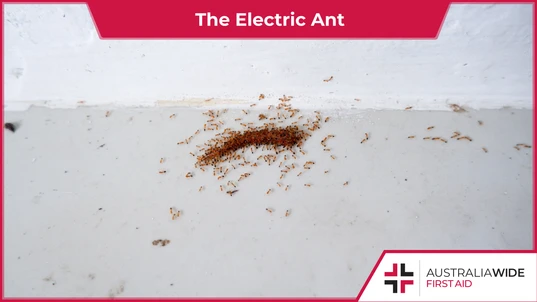First Aid for the Electric Ant

Bites and Stings

Electric ants can be found in the Cairns region of northern Queensland. They have a long-lasting, painful sting that can blind animals and cause anaphylaxis in humans.
Electric ants are tiny, slow-moving insects that can be found in Cairns and surrounding areas. Native to Central and South America, these ants are one of the world's worst invasive species and represent a major biosecurity hazard for Queensland. Likewise, they have a painful sting that can blind pets and cause severe allergic reactions in humans. As such, it is important to be wary of the Electric ant - continue reading for more information about their identifying characteristics and preferred habitat, and what to do if you encounter one.Appearance
Electric ants (wasmannia auropunctata) are golden-brown in colour and generally grow to just 1.5 mm long. Due to their miniscule size, they are typically only spotted when they form distinct foraging lines alongside their equally slow-moving counterparts. Unlike Fire ants, they are all the same size.Habitat
Electric ants can be found in the Cairns region. Rather than building visible nests, they prefer to establish their colonies in pre-existing spaces with shade and a little moisture, including:- Under stones, sleepers, and logs
- In soil, garden waste, and leaf litter
- Around swimming pools and water courses
History in Australia
Electric ants were first detected in the Cairns region of north Queensland in 2006. They are yet to be detected elsewhere in Australia. It is thought that they hitched a ride to Australia via ships and planes containing host materials, such as:- Timber
- Soil
- Rocks
- Mexico
- West Africa
- New Caledonia, among others
Danger
Electric ants represent an enormous threat to Australia's environmental, economic, and social health. For instance:- They can out-compete and displace other ant species
- Dense infestations can decline invertebrate and small vertebrate numbers and lead to an overall reduction in biodiversity
- So they can collect honeydew, they protect sap-sucking insects from other predators and can reduce the plant vigour and crop yield of agricultural farms
- Their stings can can cause painful, persistent welts and severe allergic reactions in humans
- Electric ants are attracted to pet food and have been known to attack, and in some cases blind, both domestic and wild animals
First aid
If you witness a sting from an Electric ant:- Move the casualty and others away from the Electric ants
- Calm and reassure the casualty
- Apply a cold compress to the affected area to reduce pain and swelling
- Gently wash the affected area with soap and water
- Leave the blisters intact
- Monitor for signs of anaphylaxis and respond accordingly
- Report the incident to the relevant authorities and close off the area to reduce the chances of future stings
Final thoughts
Found in the Cairns region, the Electric ant is one of the world's worst invasive species. Not only do they spell trouble for agricultural industries, but they also have a painful, long-lasting sting that can blind animals and cause severe allergic reactions in humans. If you suspect an Electric ant infestation in your home or local community, you should contact the relevant authorities to assist with their efforts in eradicating Electric ants. And if you sustain a sting from an Electric ant, take care to manage your symptoms with a cold compress. To learn more about identifying and treating a host of different insect stings, book a First Aid course with Australia Wide First Aid today.
Originally published at
https://www.australiawidefirstaid.com.au/resources/electric-ant
as part of the Australia Wide First Aid Articles Library









